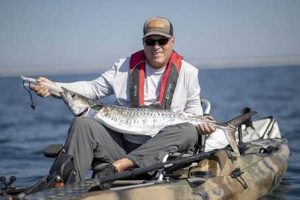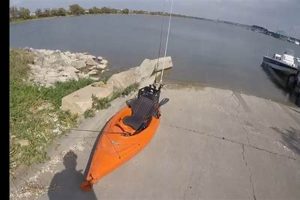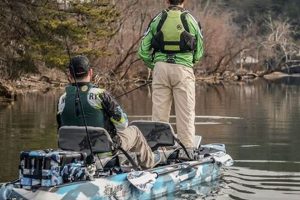Angling from a small, human-powered watercraft offers a unique blend of recreation and sport. This quiet, low-impact approach allows close contact with nature and access to shallow, secluded waters often unreachable by larger vessels. Imagine casting a line amidst tranquil lily pads or drifting silently along a reedy shoreline. This method provides an intimate connection with the aquatic environment.
This pursuit offers several advantages. The minimal disturbance of paddling allows anglers to approach fish without alarming them, increasing the likelihood of a successful catch. The slow pace affords opportunities for observation and appreciation of the surrounding ecosystem. Historically, small boats have been utilized for sustenance fishing in diverse cultures, highlighting the practicality and effectiveness of this method. This legacy continues today, offering a connection to traditional fishing practices while providing a sustainable and enjoyable recreational activity.
The following sections will explore various aspects of this activity, including suitable watercraft selection, essential equipment, effective techniques, and responsible angling practices. Further discussion will cover location selection, safety considerations, and the environmental impact of this method.
Tips for Angling from Small Human-Powered Watercraft
Successful angling from small, human-powered watercraft requires careful planning and execution. The following tips offer guidance for a safe and productive experience.
Tip 1: Choose the Right Vessel: Stability and maneuverability are key. Wider, flatter-bottomed boats offer greater stability, while kayaks provide enhanced maneuverability. Consider the targeted species and fishing environment when selecting a craft.
Tip 2: Pack Light and Efficiently: Space is limited. Essential gear includes appropriately sized rods and reels, tackle, a first-aid kit, and safety equipment. Organize gear for easy access and minimize clutter.
Tip 3: Prioritize Safety: A personal flotation device (PFD) is essential. Check weather conditions before embarking and be aware of potential hazards such as changing currents and submerged obstacles. Inform someone of the planned fishing location and estimated return time.
Tip 4: Employ Stealth Tactics: Quiet movement and minimal disturbance are crucial. Avoid sudden movements and loud noises that could spook fish. Utilize the watercraft’s low profile to approach fish discreetly.
Tip 5: Master Paddle Control: Efficient paddling conserves energy and allows for precise boat positioning. Learn basic paddling techniques for maneuvering in various wind and current conditions.
Tip 6: Respect the Environment: Practice catch-and-release whenever possible. Dispose of fishing line and other waste responsibly. Avoid disturbing natural habitats and wildlife.
Tip 7: Adapt to Conditions: Fish behavior and water conditions can change rapidly. Be prepared to adjust fishing techniques and locations based on these changes. Observe the environment and adapt accordingly.
By adhering to these guidelines, anglers can maximize their chances of success while ensuring a safe and enjoyable experience. These practices also contribute to the preservation of aquatic ecosystems for future generations.
In conclusion, angling from a small human-powered watercraft offers a rewarding and sustainable approach to fishing. Combining thoughtful preparation with a respect for nature, anglers can enjoy the tranquility and challenge of this unique pursuit.
1. Stable Watercraft
Watercraft stability is paramount for successful angling from a paddle boat. A stable platform allows for comfortable casting, accurate retrieves, and safe handling of fish. Compromised stability negatively impacts fishing effectiveness and jeopardizes angler safety. This section explores key facets of watercraft stability related to paddle boat fishing.
- Hull Design:
Hull design significantly influences stability. Wider, flatter hulls provide greater initial stability, resisting tipping during casting or landing fish. Conversely, narrower, V-shaped hulls, while efficient for paddling, offer less initial stability. Pontoon-style hulls offer exceptional stability, while catamaran designs provide a balance between stability and speed. Choosing a hull design appropriate for the intended fishing environment and angler experience is crucial. For example, a wider hull is preferable for fishing in choppy conditions.
- Center of Gravity:
Maintaining a low center of gravity enhances stability. Distributing weight evenly within the boat, avoiding sudden movements, and keeping gear stowed securely contribute to a stable center of gravity. Standing up in a paddle boat significantly raises the center of gravity and increases the risk of capsizing. Proper weight distribution, including angler position and gear placement, minimizes the risk of instability.
- Water Conditions:
Calm water conditions contribute significantly to stability. Wind, currents, and waves can destabilize a paddle boat, making fishing challenging and potentially dangerous. Assessing water conditions before embarking and choosing sheltered locations when possible enhances stability and safety. Adapting fishing techniques to prevailing water conditions, such as using a drift sock to slow movement in windy conditions, improves stability and control.
- Angler Behavior:
Angler behavior significantly influences stability. Sudden movements, leaning over the side, and shifting weight abruptly can compromise stability. Smooth, deliberate movements and maintaining a balanced posture contribute to a stable fishing platform. Practicing casting and retrieving from a seated position enhances stability and reduces the risk of capsizing.
Understanding the interplay between these factors contributes to a safer and more productive fishing experience. Selecting a stable watercraft appropriate for the intended environment and practicing safe angling techniques maximizes stability and enjoyment on the water. Ultimately, prioritizing stability ensures a successful and safe paddle boat fishing experience.
2. Essential Gear
Appropriate gear selection significantly impacts the success and enjoyment of fishing from a paddle boat. Limited space necessitates careful consideration of essential items, prioritizing functionality and efficiency. The following facets outline crucial gear categories for paddle boat angling.
- Tackle Selection:
Tackle choices should align with the target species and fishing environment. Lighter rods and reels, suitable for smaller fish and closer-range casting, are often preferred. A selection of lures, baits, and hooks appropriate for the target species is essential. Leaders and line appropriate for the target species and fishing conditions are also important. For instance, when fishing for panfish in weedy areas, lighter lines and weedless hooks are beneficial.
- Safety Equipment:
Safety remains paramount in paddle boat fishing. A personal flotation device (PFD) is mandatory and should be worn at all times. A whistle, signaling mirror, and a waterproof first-aid kit are crucial safety additions. A communication device, such as a waterproof cell phone or VHF radio, can be invaluable in emergencies. Carrying a spare paddle and a bilge pump or bailer provides additional safety and preparedness. For example, in case of capsizing, a PFD is essential for survival.
- Navigation and Electronics:
Navigational tools aid in locating fishing spots and ensuring safe return. A waterproof chart or GPS device is highly recommended, especially when fishing unfamiliar waters. A fish finder can assist in locating fish concentrations and identifying underwater structures. A headlamp or flashlight is essential for navigating in low-light conditions. A compass can also be a valuable navigational aid. Knowing how to use these tools effectively enhances safety and fishing success.
- Storage and Organization:
Efficient storage solutions maximize limited space on a paddle boat. A tackle box or bag designed for kayak or canoe fishing keeps gear organized and accessible. Dry bags protect essential items from water damage. Rod holders and paddle clips secure equipment and prevent loss. A small cooler can be used to store food and drinks as well as keep caught fish fresh. Efficient organization minimizes clutter and maximizes fishing efficiency.
Careful consideration of these essential gear categories contributes significantly to a safe, productive, and enjoyable paddle boat fishing experience. Prioritizing essential items, maximizing storage efficiency, and incorporating safety equipment enhances angler preparedness and overall success on the water.
3. Quiet Approach
A quiet approach is fundamental to successful angling from a paddle boat. Unlike motorized vessels, paddle boats offer inherent stealth, enabling anglers to approach fish without creating disruptive noise or vibrations. This minimal disturbance is crucial, as fish are easily spooked by loud sounds and abrupt movements. The quiet nature of paddle propulsion allows closer proximity to fish, increasing opportunities for observation and precise casting. This advantage is particularly significant in shallow water or clear conditions where fish are more easily alerted to potential threats. For instance, in calm, clear lakes, a quiet approach allows anglers to observe fish behavior and adjust tactics accordingly, maximizing chances of a successful catch.
The connection between a quiet approach and fishing success is amplified by the paddle boat’s low profile. The angler sits closer to the waterline, reducing visibility and minimizing shadows that could alarm fish. This low profile, coupled with the quiet operation, creates a less intrusive presence, allowing anglers to blend seamlessly into the environment. In areas with heavy vegetation or overhanging trees, a low profile and quiet approach are essential for navigating tight spaces and accessing secluded fishing spots without disturbing the surrounding ecosystem. This allows anglers to target fish in their natural habitat, increasing the likelihood of a successful catch.
Mastering a quiet approach requires mindful paddling techniques and careful boat control. Smooth, deliberate paddle strokes minimize splashing and reduce noise. Avoiding sudden movements and excessive gear shifting further enhances stealth. Practicing efficient paddling techniques allows anglers to maintain control while minimizing disturbance, maximizing the benefits of a quiet approach. This mindful approach not only increases fishing success but also fosters a deeper connection with the natural environment. By embracing the quiet nature of paddle boats, anglers can experience a more rewarding and sustainable approach to fishing.
4. Safe Practices
Safe practices are integral to responsible and enjoyable paddle boat fishing. Neglecting safety protocols can lead to accidents, injuries, and even fatalities. The inherent risks associated with on-water activities are amplified by the small size and open design of paddle boats. Understanding and implementing appropriate safety measures significantly mitigates these risks, ensuring a positive experience. For example, wearing a personal flotation device (PFD) is crucial, even in calm waters, as unexpected conditions can quickly arise. A PFD can prevent drowning in the event of capsizing or falling overboard, particularly in cold water where hypothermia can set in rapidly.
Several key safety practices contribute to a secure paddle boat fishing experience. Checking weather forecasts before embarking is essential, as sudden changes in wind speed or direction can create hazardous conditions, especially on larger bodies of water. Informing someone of the planned fishing location and estimated return time is another crucial precaution. This allows for prompt assistance in case of an emergency or overdue return. Carrying a communication device, such as a VHF radio or a waterproof cell phone, enables contact with emergency services if needed. Furthermore, understanding basic navigation and boat handling skills is essential for maintaining control and avoiding collisions with other vessels or obstacles. Regularly inspecting and maintaining the paddle boat, including checking for leaks and ensuring proper functioning of all equipment, further enhances safety.
Ultimately, prioritizing safe practices contributes significantly to a positive and sustainable paddle boat fishing experience. Careful planning, adherence to safety guidelines, and continuous awareness of environmental conditions minimize potential risks and maximize enjoyment on the water. Understanding the potential hazards and implementing appropriate safety measures ensures a responsible and enjoyable experience for all paddle boat anglers. This proactive approach not only protects individual safety but also fosters a culture of responsible use of waterways and respect for the natural environment.
5. Respectful Angling
Respectful angling represents a crucial element of sustainable paddle boat fishing. The low-impact nature of paddle boats offers unique opportunities for close interaction with aquatic ecosystems. This proximity amplifies the importance of minimizing environmental impact and preserving natural resources. Respectful angling practices, such as catch-and-release fishing and proper handling techniques, minimize stress on fish populations and maintain healthy ecosystems. For example, using barbless hooks allows for easier hook removal and reduces the risk of injury to fish, increasing their chances of survival after release. Similarly, wetting hands before handling fish helps protect their delicate slime coat, which acts as a natural barrier against parasites and infections. These seemingly small actions contribute significantly to the long-term health and sustainability of fish populations.
Paddle boat fishing often takes place in shallower, more sensitive environments compared to motorized boating. These areas, including estuaries, headwaters, and small lakes, play critical roles in the lifecycle of many aquatic species. Respectful angling practices, such as avoiding disturbing spawning beds and minimizing disruption to vegetation, are essential for preserving these fragile habitats. Improperly discarded fishing line, for example, can entangle wildlife and damage aquatic vegetation. Carrying a small receptacle for used line and other debris demonstrates responsible angling and contributes to maintaining healthy aquatic environments. Furthermore, respecting local fishing regulations, including catch limits and size restrictions, ensures sustainable fishing practices and protects vulnerable fish populations.
Respectful angling fosters a deeper connection between anglers and the natural environment. By prioritizing the well-being of aquatic ecosystems, anglers contribute to the long-term sustainability of the sport and ensure its enjoyment for future generations. The quiet, non-intrusive nature of paddle boat fishing allows for greater appreciation of the natural world and fosters a sense of responsibility for its preservation. This mindful approach to fishing enhances not only the angling experience but also the overall health and resilience of aquatic environments. Challenges remain in promoting widespread adoption of respectful angling practices. Education and outreach initiatives, highlighting the ecological benefits of responsible angling, can encourage greater awareness and foster a culture of environmental stewardship within the paddle boat fishing community.
Frequently Asked Questions
This section addresses common inquiries regarding angling from small, human-powered watercraft. Clear and concise responses aim to provide comprehensive information for both novice and experienced anglers.
Question 1: What type of paddle craft is best suited for fishing?
Several factors influence watercraft suitability, including fishing style, target species, and water conditions. Wider, more stable platforms, such as canoes or pontoon-style kayaks, offer greater stability for casting and landing fish, while narrower kayaks provide enhanced maneuverability in confined spaces. Careful consideration of individual needs and intended fishing environments is recommended.
Question 2: What essential safety precautions should one take when fishing from a paddle boat?
Wearing a personal flotation device (PFD) is paramount. Checking weather forecasts prior to departure and informing someone of the intended fishing location and return time are also crucial. Carrying a communication device, such as a VHF radio or waterproof cell phone, is highly recommended. Familiarity with basic navigation and boat handling skills is also essential.
Question 3: How does one maintain stability while fishing from a small watercraft?
Distributing weight evenly within the boat is critical for maintaining stability. Avoiding sudden movements and keeping gear stowed securely minimizes the risk of capsizing. Practicing casting and retrieving techniques from a seated position enhances balance and control. Selecting a watercraft with a stable hull design contributes significantly to overall stability.
Question 4: What are the advantages of fishing from a paddle boat compared to a motorized boat?
Paddle boats offer a quiet, non-intrusive approach, allowing anglers to access shallow, secluded waters often unreachable by larger vessels. The absence of motor noise minimizes disturbance to fish and enhances the overall angling experience. This low-impact approach also aligns with principles of environmental stewardship.
Question 5: What specialized equipment is recommended for paddle boat fishing?
Specialized equipment enhances both safety and fishing success. Rod holders, anchor trolleys, and fish finders designed specifically for kayaks or canoes improve functionality. Dry bags protect essential gear from water damage. Lightweight, compact tackle and appropriately sized rods and reels are recommended for efficient space utilization.
Question 6: How can one minimize environmental impact while paddle boat fishing?
Practicing catch-and-release fishing, using barbless hooks, and handling fish with wet hands minimizes stress on fish populations. Proper disposal of fishing line and other waste prevents pollution and protects wildlife. Respecting local fishing regulations and avoiding disturbance to sensitive habitats contribute to ecosystem preservation.
Careful consideration of these frequently asked questions enhances angler preparedness and promotes responsible enjoyment of paddle boat fishing. Prioritizing safety, respecting the environment, and utilizing appropriate equipment contribute to a positive and sustainable angling experience.
The subsequent section delves further into specific techniques for various fish species and diverse aquatic environments.
Fishing on a Paddle Boat
This exploration has highlighted the multifaceted nature of angling from human-powered watercraft. From equipment selection and safety considerations to respectful angling practices and environmental stewardship, the pursuit demands careful planning and execution. The advantages of a quiet, low-impact approach, coupled with access to secluded waters, offer unique opportunities for connection with nature and successful angling. Emphasis on stability, appropriate gear, and a mindful approach contributes significantly to a rewarding experience. The discussion encompassed essential aspects such as watercraft selection, tackle choices, safety protocols, and techniques for minimizing environmental impact. Furthermore, the importance of adapting to specific water conditions and target species was underscored.
Angling from a paddle boat represents more than simply catching fish; it embodies a connection with aquatic ecosystems and a commitment to their preservation. This pursuit offers a unique blend of recreation, skill development, and environmental awareness. As anglers increasingly seek sustainable and immersive outdoor experiences, the popularity of this method is likely to grow. Continued emphasis on responsible angling practices will ensure the long-term health of aquatic environments and the enduring enjoyment of this rewarding pursuit. The future of paddle boat fishing rests on the collective commitment to preserving the delicate balance between human interaction and ecological integrity.






